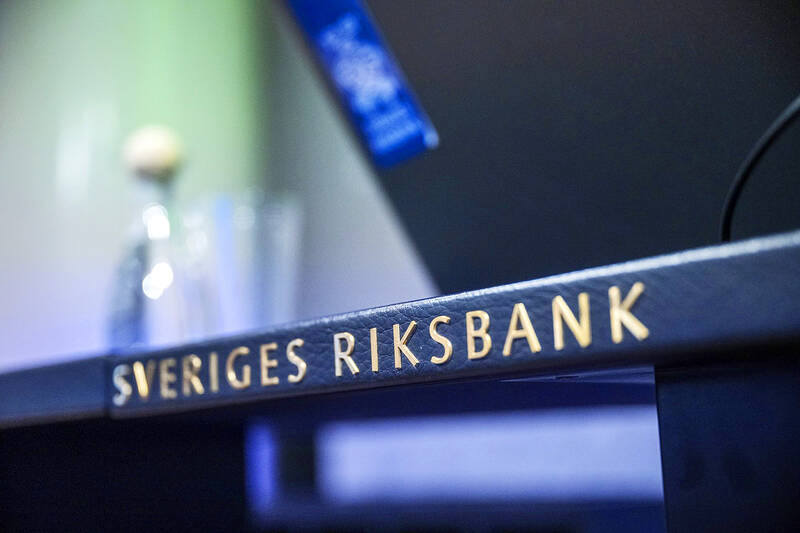The Riksbank raised its interest rate by a full percentage point in its most aggressive tightening of almost three decades of inflation targeting, starting a global round of monetary policy action to bring prices under control.
The Swedish central bank lifted its policy rate to 1.75 percent, defying the forecasts of most economists for a smaller move as officials escalated their response to price increases that have exceeded their forecasts for 11 straight months.
“The risk is still large that inflation becomes entrenched and it is extremely important that monetary policy acts to ensure that inflation falls back and stabilizes,” officials said in a statement in Stockholm.

Photo: Bloomberg
“Monetary policy now needs to act more than was anticipated in June,” they said.
By this time next year, the rate is likely to have reached 2.5 percent, which implies another 0.75 percentage points in tightening, their new forecasts showed.
The outsized move places the Riksbank alongside the Bank of Canada as the only two central banks overseeing the world’s 10 most-traded currencies to have hiked by such an amount this year.
The decision is a prelude to the highlight of the week, when US Federal Reserve policymakers are predicted to stick with a 75 basis point increase amid some investor speculation that they could go for a bigger increment as the Swedes have done.
Other counterparts also anticipated to hike rates this week include the Bank of England, the Swiss National Bank and Norway’s central bank, all of which are expected to keep up or even intensify the aggression of their policy stances.
Swedish inflation last month reached another three-decade high at 9 percent, highlighting how policymakers had underestimated price increases after what was long one of the most stimulus-friendly approaches in the rich world.
As it seeks to catch up, the Riksbank is facing a dilemma familiar to its global peers of how to dampen inflation without too much harm to the economy. That is especially acute in Sweden, where household indebtedness is high and more than 40 percent of outstanding mortgages feature rates that are set for periods of no more than three months.
The increase in borrowing costs has so far led to an 8 percent decline in house prices from a peak earlier this year, and a simultaneous run-up in energy and mortgage costs could lead to an accelerated slump.
The Riksbank cut all its growth forecasts and now expects the Swedish economy to contract 0.7 percent next year instead of expanding by that amount.
“It would be even more painful for the Swedish economy if inflation were to remain at the current high levels,” officials said. “By raising the policy rate more now, the risk of high inflation in the longer term is reduced and thereby the need for an even greater monetary tightening further ahead.”

UNCERTAINTIES: Exports surged 34.1% and private investment grew 7.03% to outpace expectations in the first half, although US tariffs could stall momentum The Chung-Hua Institution for Economic Research (CIER, 中華經濟研究院) yesterday raised its GDP growth forecast to 3.05 percent this year on a robust first-half performance, but warned that US tariff threats and external uncertainty could stall momentum in the second half of the year. “The first half proved exceptionally strong, allowing room for optimism,” CIER president Lien Hsien-ming (連賢明) said. “But the growth momentum may slow moving forward due to US tariffs.” The tariff threat poses definite downside risks, although the scale of the impact remains unclear given the unpredictability of US President Donald Trump’s policies, Lien said. Despite the headwinds, Taiwan is likely

When Lika Megreladze was a child, life in her native western Georgian region of Guria revolved around tea. Her mother worked for decades as a scientist at the Soviet Union’s Institute of Tea and Subtropical Crops in the village of Anaseuli, Georgia, perfecting cultivation methods for a Georgian tea industry that supplied the bulk of the vast communist state’s brews. “When I was a child, this was only my mum’s workplace. Only later I realized that it was something big,” she said. Now, the institute lies abandoned. Yellowed papers are strewn around its decaying corridors, and a statue of Soviet founder Vladimir Lenin

UNIFYING OPPOSITION: Numerous companies have registered complaints over the potential levies, bringing together rival automakers in voicing their reservations US President Donald Trump is readying plans for industry-specific tariffs to kick in alongside his country-by-country duties in two weeks, ramping up his push to reshape the US’ standing in the global trading system by penalizing purchases from abroad. Administration officials could release details of Trump’s planned 50 percent duty on copper in the days before they are set to take effect on Friday next week, a person familiar with the matter said. That is the same date Trump’s “reciprocal” levies on products from more than 100 nations are slated to begin. Trump on Tuesday said that he is likely to impose tariffs

READY TO BUY: Shortly after Nvidia announced the approval, Chinese firms scrambled to order the H20 GPUs, which the company must send to the US government for approval Nvidia Corp chief executive officer Jensen Huang (黃仁勳) late on Monday said the technology giant has won approval from US President Donald Trump’s administration to sell its advanced H20 graphics processing units (GPUs) used to develop artificial intelligence (AI) to China. The news came in a company blog post late on Monday and Huang also spoke about the coup on China’s state-run China Global Television Network in remarks shown on X. “The US government has assured Nvidia that licenses will be granted, and Nvidia hopes to start deliveries soon,” the post said. “Today, I’m announcing that the US government has approved for us